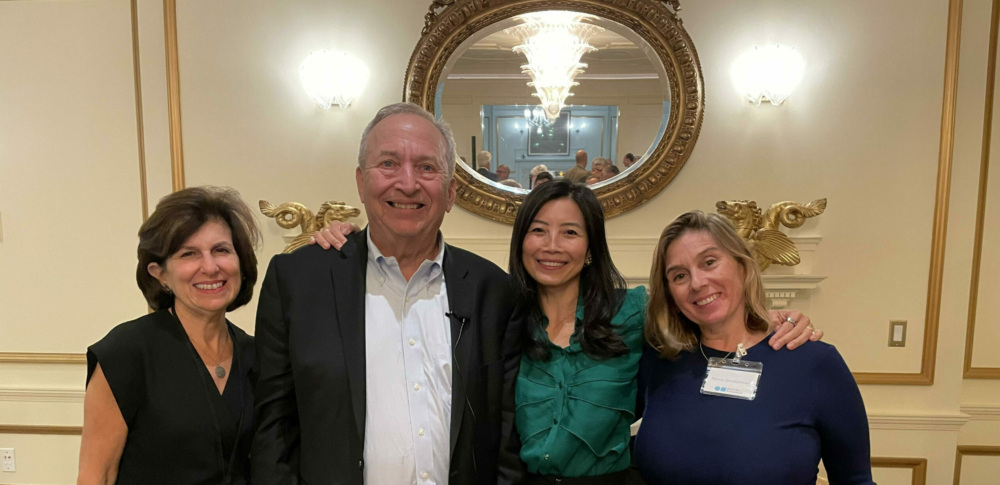

Impact Investments, Workforce & Economic Mobility
Key Takeaway
Good jobs with sustainable wages exist—and are in high demand. More urgently than ever, we need to find alternative pathways to training and education that prepare people for these jobs and make it possible for those who have left to return to, and advance in, the labor force.
Last month, we gathered friends and supporters in Boston for a dinner discussion on the current economy and new models for impact. Larry Summers joined Tracy Palandjian, Social Finance CEO and Co-Founder, to reflect on the precarity of this moment and how innovative investment and partnership models are working to measurably build economic opportunity for people and communities. For us, the evening consisted of great conversations with old friends, many new connections, and rich insights from Larry and Tracy’s discussion.
In our country, I think the battle for our future is going to be won or lost in whether we can create viable life paths of dignity, respect, building, and success for the 60% of Americans who do not have a four-year college degree. And the question is, what is the decent and viable alternative?Lawrence H. Summers
The first part of the conversation focused on work and education, with Larry reflecting that in this post-pandemic moment, 15% of the population is not working (versus just 5% in 1965). Sociologists and economists are puzzled because we don’t know why people are staying out of the workforce. Tracy asked, “Is it a lack of pathways? Because there are 10 million unfilled job openings around the country, many of which are good jobs with good pay. Even if we start to see fewer job vacancies in an economic slowdown, we will still have more jobs open than people looking for work.”
What we do know is that good jobs with sustainable wages exist—and are in high demand. More urgently than ever, we need to find alternative pathways to training and education that prepare people for these jobs and make it possible for those who have left to return to, and advance in, the labor force.
Economists and sociologists are struggling to explain today's unprecedentedly low labor force participation rate, especially among prime-working-age men. But what if we had clearer and more effective pathways for upskilling people and helping them move up the economic escalator?Tracy Palandjian
Larry and Tracy discussed many barriers to this vision, including the incentive structures within higher education; siloes between educational institutions, governments, and companies; and a cultural priority placed on college. To move forward, we must better connect and align the education and employment systems. Only by doing so can we support more people in getting the skills they need to retain jobs with sustainable pay and growth potential.
In pursuit of this future, at Social Finance we build cross-sector partnerships that align governments, companies, and education and training providers around employment goals, and we finance training and support for individuals who may otherwise lack access to opportunity.
The next time somebody says not to worry about inflation, I suggest you consider a hospital. A third of nurses are burned out, we are facing a national shortage of allied healthcare workers, and no one has gotten any elective surgery for two years. So guess what? Health care inflation is not coming down. Prices are going to have to go up. And health care is a large component of the CPI.Lawrence H. Summers
Larry and Tracy’s discussion of workforce education was closely tied to one of today’s most pressing economic concerns: inflation. The people being hit the hardest by inflation—those at the lower end of the wealth distribution—stand to benefit the most from improved education and training pathways. Tracy described the status quo: “The learner bears all the risk, taking time off from work and incurring debt, with no guarantee that the journey will yield skills or a degree that lead to a living wage.”
At Social Finance, we are reworking the risk equation. When we finance training, individuals only repay if they land a job earning family-sustaining wages. In many of our programs, governments and employers take on financial responsibility—and accountability towards outcomes—as well. While companies are too often passive consumers of talent, we imagine a world where employers are an active investor in and designer of the workforce. Particularly in moments of economic uncertainty like today, we believe it is critical to share risk across those who benefit.
Ultimately, it's going to be about the people in this country, what they're able to do, and the ways they're able to work together or not work together. And that's why the work Social Finance does is so exciting.Lawrence H. Summers
Larry ended the discussion on a hopeful note: the economic and social uncertainty of the moment give us the opportunity to reimagine how we work together to drive change. At Social Finance, we are embracing this opportunity. We’re asking governments, educators, companies, investors, and funders to work together to deliver measurable outcomes for our communities. Our hope is that last month’s discussion was the first of many, and that we can continue to wrestle with these tough issues as we work to reboot economic mobility across the country.
Annie Knickman Plancher is Vice President of Partnerships and Strategy at Social Finance. Laurene Sperling and Nancy Zimmerman are members of Social Finance’s Board of Directors.
Related Insight
